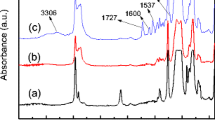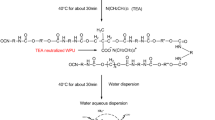Abstract
Segmented poly(urethane-urea-siloxane)s (PUUS) were synthesized using 4,4′-methylenediphenyl diisocyanate (MDI) and ethylene diamine (ED) as the hard segment components and hydroxypropyl-terminated poly(dimethylsiloxane) (PDMS) as the soft segment component, where the hard segment content ranged from 38 to 65 wt%. Segmented PUUSs were prepared by a two-step polymerization procedure in tetrahydrofuran/N-methylpyrrolidone (THF/NMP) mixture with a large proportion of polar solvent. The structure, composition and hard segment length were determined by 13C NMR and two-dimensional correlation spectroscopy. Thermal, mechanical, small-angle X-ray scattering and hydrogen bonding analyses indicated the formation of the microphase-separated copolymers with high tensile strength. Globular superstructures observed in the copolymer films by scanning electron microscopy (SEM) and atomic force microscopy (AFM) were probably arisen from the microstructural organization of the MDI-ED segments, depending on their content and length. The PUUS copolymers showed high water resistance and became more hydrophobic with increasing weight fraction of PDMS.












Similar content being viewed by others
References
Dvornic PR, Lenz RW (1990) High temperature siloxane elastomers. Hüthing and Wepf, Heidelberg
Yilgör I, McGrath JE (1988) Polysiloxane containing copolymers: a survey of recent developments. Adv Polym Sci 86:1–86. doi:10.1007/BFb0025274
Stokes K, McVenes R, Anderson JM (1995) Polyurethane elastomer biostability. J Biomater Appl 9:321–354. doi:10.1177/088532829500900402
Petrovic ZS, Ferguson J (1991) Polyurethane elastomers. Prog Polym Sci 16:695–836. doi:10.1016/0079-6700(91)90011-9
Seymour W, Cooper SL (1973) Thermal analysis of polyurethane block polymers. Macromolecules 6:48–53. doi:10.1021/ma60031a008
Sarva SS, Hsieh AJ (2009) The effect of microstructure on the rate-dependent stress-strain behavior of poly(urethane urea) elastomers. Polymer 50:3007–3015. doi:10.1016/j.polymer.2009.04.025
Li H, Freeman BD, Ekiner OM (2011) Gas permeation properties of poly(urethane-urea)s containing different polyethers. J Membrane Sci 369:49–58. doi:10.1016/j.memsci.2010.11.024
Ning L, Ning WD, Kang YS (1996) Crystallinity and hydrogen bonding of hard segments in segmented poly(urethane urea) copolymers. Polymer 37:3577–3583. doi:10.1016/0032-3861(96)00166-8
Spaans CJ, de Groot JH, Dekens FG, Pennings AJ (1998) High molecular weight polyurethanes and a polyurethane urea based on 1,4-butanediisocyanate. Polym Bull 41:131–138. doi:10.1007/s002890050343
Sheth JP, Aneja A, Wilkes GL, Yilgor E, Atilla GE, Yilgor I, Beyer FL (2004) Influence of system variables on the morphological and dynamic mechanical behavior of polydimethylsiloxane based segmented polyurethane and polyurea copolymers: a comparative perspective. Polymer 45:6919–6932. doi:10.1016/j.polymer.2004.06.057
Yilgor I, Eynur T, Yilgor E, Wilkes GL (2009) Contribution of soft segment entanglement on the tensile properties of silicone-urea copolymers with low hard segment contents. Polymer 50:4432–4437. doi:10.1016/j.polymer.2009.07.016
Yilgor E, Burgaz E, Yurtsever E, Yilgor I (2000) Comparison of hydrogen bonding in polydimethylsiloxane and polyether based urethane and urea copolymers. Polymer 41:849–857. doi:10.1016/S0032-3861(99)00245-1
Xue-Hai Yu, Nagarajan MR, Grasel TG, Gibson PE, Cooper SL (1985) Polydimethylsiloxane–polyurethane elastomers: synthesis and properties of segmented copolymers and related zwitter ionomers. J Polym Sci B Polym Phys 23:2319–2338. doi:10.1002/pol.1985.180231106
Wang LF, Ji Q, Glass TE, Ward TC, McGrath JE, Muggli M, Burns G, Sorathia U (2000) Synthesis and characterization of organosiloxane modified segmented polyether polyurethanes. Polymer 41:5083–5093. doi:10.1016/S0032-3861(99)00570-4
Hergenrother RW, Yu XH, Cooper SL (1994) Blood-contacting properties of polydimethylsiloxane polyurea–urethanes. Biomaterials 15:635–640. doi:10.1016/0142-9612(94)90215-1
Balaban M, Antić V, Pergal M, Francolini I, Martinelli A, Djonlagić J (2012) The effect of the polar solvents on the synthesis of poly(urethane-urea-siloxane)s. J Serb Chem Soc 77:1457–1481. doi:10.2298/JSC111025056B
Kaji A, Murano M (1990) Sequence distribution of segmented polyurethane–urea. Polym J 22:1065–1075. doi:10.1295/polymj.22.1065
Luo N, Wang DN, Ying SH (1996) Study on sequence distribution of segmented poly(urethane urea)s by 13C-NMR spectroscopy: effect of polymerization procedures. J Polym Sci A 34:2157–2161. doi:10.1002/(SICI)1099-0518(199608)34:11<2157:AID-POLA8>3.0.CO;2-W
Ilarduya AM, Carvalho E, Alla A, Muñoz-Guerra S (2010) Sequence analysis of polyether-based thermoplastic polyurethane elastomers by 13C NMR. Macromolecules 43:3990–3993. doi:10.1021/ma100395x
Zong J, Zhang Q, Sun H, Yu Y, Wang S, Liu Y (2010) Characterization of polydimethylsiloxane–polyurethanes synthesized by graft or block copolymerizations. Polym Bull 65:477–493. doi:10.1007/s00289-010-0262-5
Garrett JT, Lin JS, Runt J (2002) Influence of preparation conditions on microdomain formation in poly(urethane urea) block copolymers. Macromolecules 35:161–168. doi:10.1021/ma010915d
Teo L-S, Chen C-Y, Kuo J-F (1997) Fourier transform infrared spectroscopy study on effects of temperature on hydrogen bonding in amine-containing polyurethanes and poly(urethane-urea)s. Macromolecules 30:1793–1799. doi:10.1021/ma961035f
Yilgor E, Yurtsever E, Yilgor I (2002) Hydrogen bonding and polyurethane morphology. II. Spectroscopic, thermal and crystallization behavior of polyether blends with 1,3-dimethylurea and a model urethane compound. Polymer 43:6561–6568. doi:10.1016/S0032-3861(02)00566-9
Garrett JT, Xu R, Cho J, Runt J (2003) Phase separation of diamine chain-extended poly(urethane) copolymers: FTIR spectroscopy and phase transitions. Polymer 44:2711–2719. doi:10.1016/S0032-3861(03)00165-4
Zhang S, Ren Z, He S, Zhu Y, Zhu C (2007) FTIR spectroscopic characterization of polyurethane-urea model hard segments (PUUMHS) based on three diamine chain extenders. Spectrochim Acta A 66:188–193. doi:10.1016/j.saa.2006.02.041
Yilgor I, Yilgor E, Ward TC, Guler IG, Wilkes GL (2006) FTIR investigation of the influence of diisocyanate symmetry on the morphology development in model segmented polyurethanes. Polymer 47:4105–4114. doi:10.1016/j.polymer.2006.02.027
Yilgor I, Yilgor E, Das S, Wilkes GL (2009) Time-dependent morphology development in segmented polyetherurea copolymers based on aromatic diisocyanates. J Polym Sci B 47:471–483. doi:10.1002/polb.21652
Adhikari R, Gunatillake PA, Bown M (2003) Effect of polydimethylsiloxane macrodiol molecular weight on properties and morphology of polyurethane and polyurethaneurea. J Appl Polym Sci 90:1565–1573. doi:10.1002/app.12748
Song YM, Chen WC, Liu KH, Tseng YH (1996) Effect of isocyanates on the crystallinity and thermal stability of polyurethanes. J Appl Polym Sci 62:827–834. doi:10.1002/(SICI)1097-4628(19961031)62:5<827:AID-APP15>3.0.CO;2-P
Sheth JP, Yilgor E, Erenturk B, Ozhalici H, Yilgor I, Wilkes GL (2005) Structure-property behavior of poly(dimethylsiloxane) based segmented polyurea copolymers modified with poly(propylene oxide). Polymer 46:8185–8193. doi:10.1016/j.polylmer.2005.06.050
Sheth JP, Klinedinst DB, Wilkes GL, Yilgor I, Yilgor E (2005) Role of chain symmetry and hydrogen bonding in segmented copolymers with monodisperse hard segments. Polymer 46:7317–7322. doi:10.1016/j.polymer.2005.04.041
Yilgor E, Atilla GE, Ekin A, Kurt P, Yilgor I (2003) Isopropyl alcohol: an unusual, powerful, ‘green’ solvent for the preparation of silicone-urea copolymers with high urea contents. Polymer 44:7787–7793. doi:10.1016/j.polymer.2003.10.048
Abouzahr S, Wilkes GL, Ophir Z (1982) Structure-property behaviour of segmented polyether-MDI-butanediol based urethanes: effect of composition ratio. Polymer 23:1077–1086. doi:10.1016/0032-3861(82)90411-6
Liu C, Hu CP (2009) Synthesis, characterization and in vitro oxidative stability of poly(3,3,3-trifluoropropyl)methylsiloxane modified polyurethaneurea. Polym Degrad Stab 94:259–266. doi:10.1016/j.polymdegradstab.2008.10.022
Childs MA, Matlock DD, Dorgan JR, Ohno TR (2001) Surface morphology of poly(caprolactone)-b-poly(dimethylsiloxane)-b-poly(caprolactone) copolymers: effects on protein adsorption. Biomacromolecules 2:526–537. doi:10.1021/bm0100054PMid:11749216
Madhavan K, Reddy BSR (2006) Poly(dimethylsiloxane-urethane) membranes: effect of hard segment in urethane on gas transport properties. J Membrane Sci 283:357–365. doi:10.1016/j.memsci.2006.07.005
Pergal MV, Antic VV, Govedarica MN, Godjevac D, Ostojic S, Djonlagic J (2011) Synthesis and characterization of novel urethane-siloxane copolymers with a high content of PCL-PDMS-PCL segments. J Appl Polym Sci 122:2715–2730. doi:10.1002/app.33926
Lee YH, Kim EJ, Kim HD (2011) Synthesis and properties of waterborne poly(urethane urea)s containing polydimethylsiloxane. J Appl Polym Sci 120:212–219. doi:10.1002/app.33007
Acknowledgments
This work was financially supported by the Ministry of Education and Science of the Republic of Serbia (Project No. 172062).
Author information
Authors and Affiliations
Corresponding author
Rights and permissions
About this article
Cite this article
Balaban, M., Antić, V., Pergal, M. et al. Influence of the chemical structure of poly(urea-urethane-siloxane)s on their morphological, surface and thermal properties. Polym. Bull. 70, 2493–2518 (2013). https://doi.org/10.1007/s00289-013-0968-2
Received:
Accepted:
Published:
Issue Date:
DOI: https://doi.org/10.1007/s00289-013-0968-2




